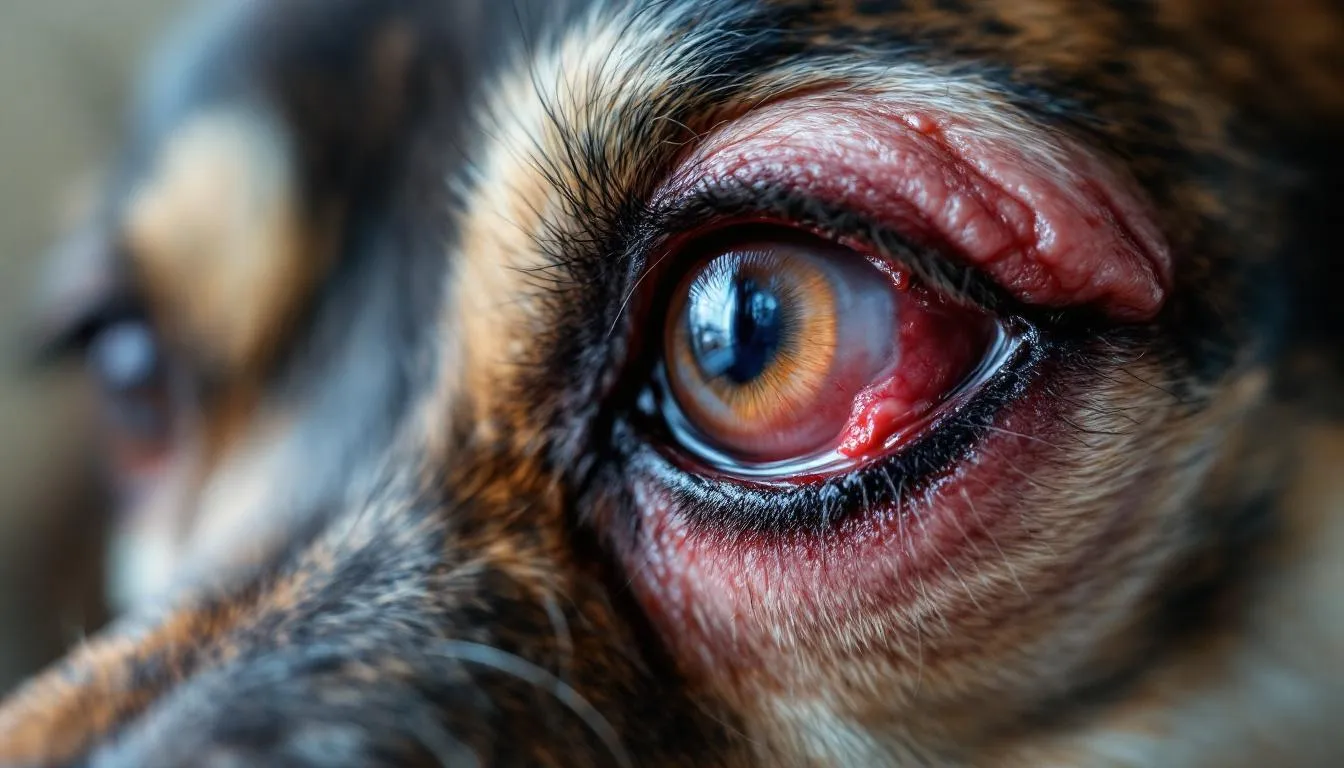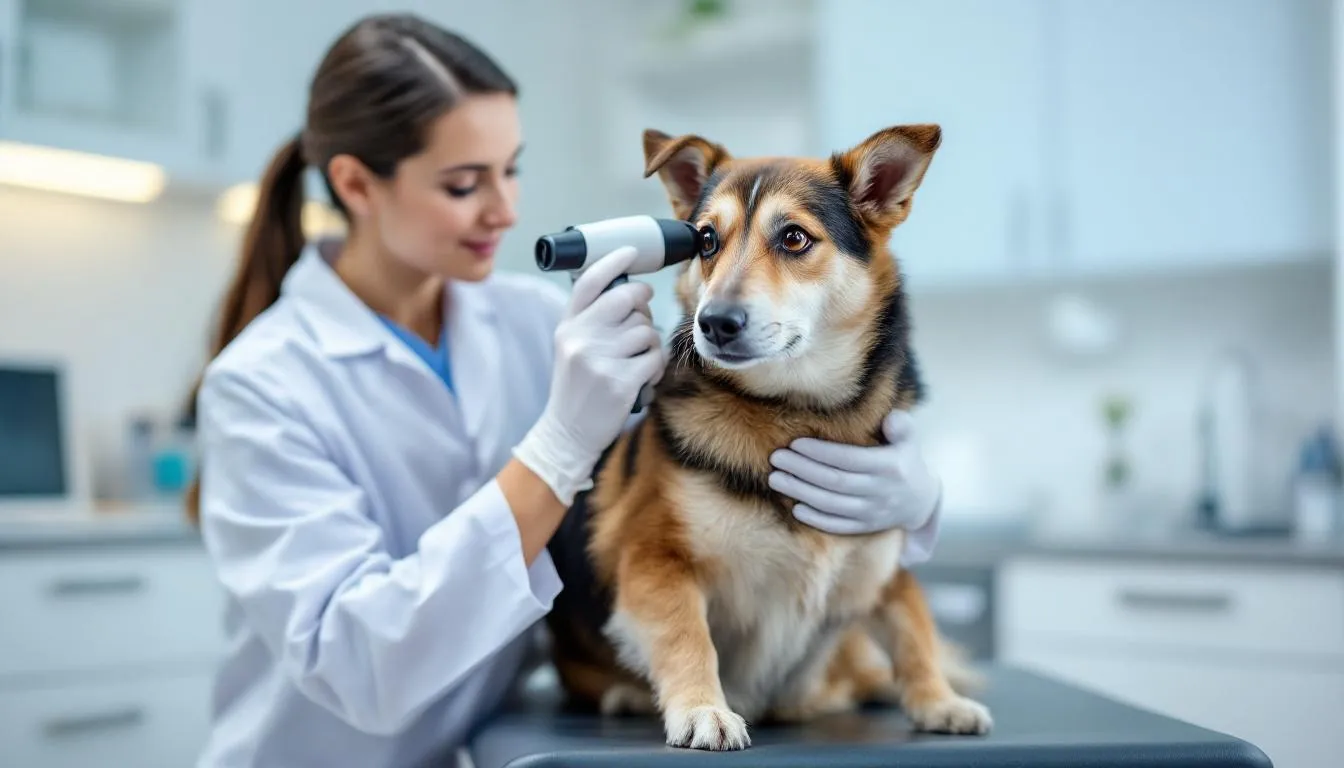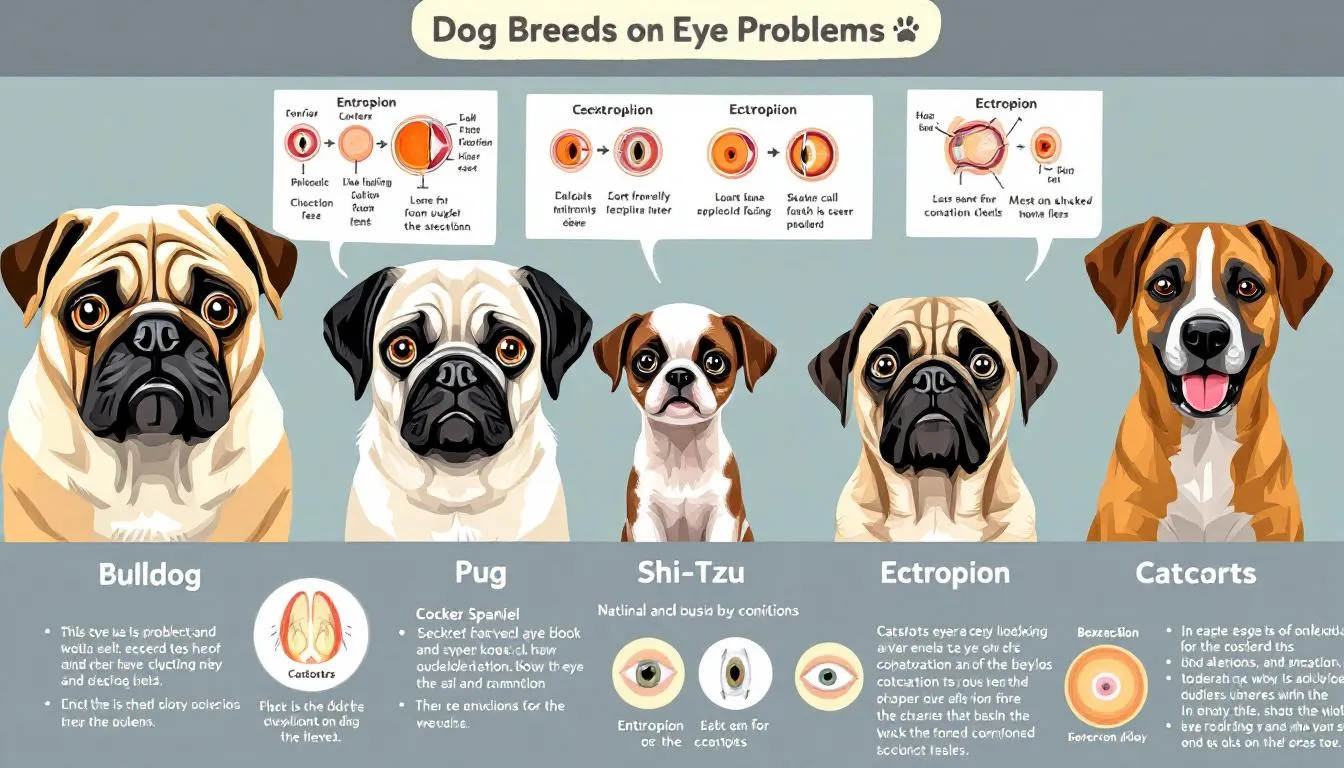Key Takeaways
- Red eyes in dogs indicate inflammation of blood vessels and can signal anything from minor allergies to serious conditions like glaucoma
- Common causes include conjunctivitis, allergies, dry eye syndrome, corneal ulcers, eye injuries, and breed-specific susceptibilities
- Immediate veterinary attention is essential for accurate diagnosis, as home remedies can worsen conditions and delay proper treatment
- Treatment varies from medicated eye drops and anti inflammatory eye drops to surgical intervention depending on the underlying cause
- Early intervention prevents complications like vision loss, corneal damage, and chronic eye conditions
Red eyes in dogs indicate inflammation of blood vessels and can signal anything from minor allergies to serious conditions like glaucoma
Common causes include conjunctivitis, allergies, dry eye syndrome, corneal ulcers, eye injuries, and breed-specific susceptibilities
Immediate veterinary attention is essential for accurate diagnosis, as home remedies can worsen conditions and delay proper treatment
Treatment varies from medicated eye drops and anti inflammatory eye drops to surgical intervention depending on the underlying cause
Early intervention prevents complications like vision loss, corneal damage, and chronic eye conditions
When you notice your dog’s eyes are red, it’s natural to feel concerned. Eye redness in dogs is more than just a cosmetic issue—it’s a clinical sign that indicates inflammation and potentially serious underlying conditions affecting your pet’s eyes. Understanding what causes red eye on dog and recognizing when to seek help can make the difference between a minor treatment and a vision-threatening emergency.
Red eyes in dogs occur when blood vessels in the eye become dilated and inflamed, creating the characteristic bloodshot appearance. This inflammation can affect different parts of the eye, from the outer conjunctiva to deeper structures, and may signal conditions ranging from simple environmental irritants to aggressive medical treatment-requiring diseases like glaucoma.


Understanding Red Eyes in Dogs
Red eye on dog represents visible inflammation causing blood vessel dilation throughout various eye structures. Unlike normal variations in eye color or temporary redness from excitement, pathological eye redness persists and often worsens without intervention. This condition indicates that your dog’s eye health is compromised and requires attention to identify the underlying cause.
Dogs’ eyes are particularly sensitive to inflammation due to their anatomical structure and environmental exposure. The prominent position of many dogs’ eyes, especially in flat faced breeds, makes them vulnerable to injury and irritation. Additionally, the complex network of small blood vessels throughout the eye readily responds to inflammation by becoming engorged and visible, creating the red appearance that signals trouble. Changes or abnormalities on the eye's surface, such as redness or cloudiness, can indicate underlying problems or specific diseases affecting your dog's vision and overall eye health.
Types of Eye Redness in Dogs
Understanding the different anatomical locations where redness occurs helps determine the severity and likely causes of your dog’s condition. Each type of redness suggests different underlying problems and treatment approaches. It is important to consult a veterinarian to accurately diagnose and treat your dog's condition before starting any treatment.
Conjunctival Hyperemia
Conjunctival hyperemia involves enlarged blood vessels in the conjunctiva, the thin tissue covering the white part of the eye and lining the eyelids. This type of redness usually indicates external eye diseases such as allergic reactions, bacterial infections, or environmental irritants. The affected area appears pink or red against the normally white sclera, often accompanied by clear or mucoid eye discharge, excessive tearing, or signs of itchy eyes as dogs paw at the affected area. Irritated eyes are commonly seen in these cases, as environmental factors or allergies can lead to redness and discomfort.
Episcleral Injection
Episcleral injection represents deeper blood vessel enlargement within the sclera, the tough outer layer of the eye. This condition signals more serious internal eye diseases such as uveitis or glaucoma, requiring immediate veterinary attention. The redness appears as darker red streaks or overall discoloration and indicates increased pressure or inflammation within the eye itself, potentially threatening your dog’s vision.
Subconjunctival Hemorrhage
Subconjunctival hemorrhage occurs when blood pools under the conjunctiva, creating diffuse, bright red patches that may cover large areas of the eye’s white surface. This dramatic-appearing condition often results from trauma, excessive restraint during grooming or veterinary procedures, or blood clotting disorders. High blood pressure is another systemic condition that can contribute to subconjunctival hemorrhage in dogs. While usually painless, subconjunctival hemorrhage requires veterinary evaluation to rule out serious underlying causes affecting blood pressure or clotting function.
Corneal Neovascularization
Corneal neovascularization involves new blood vessel formation on the normally clear cornea in response to corneal injury, chronic irritation, or disease. These vessels can be superficial or deep, and when severe, they affect the dog’s vision by clouding the transparent cornea. This condition indicates ongoing inflammation that requires treatment to prevent permanent vision loss and preserve the eye’s surface integrity, with a key goal being decreasing inflammation to protect vision and reduce further damage.


Common Causes of Red Eyes in Dogs
Various factors can trigger eye redness in dogs, ranging from temporary environmental irritation to serious medical conditions requiring aggressive medical treatment. Understanding these causes helps pet owners recognize when their dog’s red eyes represent an emergency versus a manageable condition. Dogs red eyes can be a sign of inflammation or underlying medical conditions that require prompt veterinary attention.
Allergic Reactions
Environmental allergens including pollen, dust, mold, and dander commonly cause conjunctival irritation leading to red eyes in dogs. These allergic reactions often follow seasonal patterns, with symptoms intensifying during high pollen periods in spring and fall. Dogs allergies typically produce bilateral eye involvement with watery discharge, intense itching leading to eye rubbing, and mild to moderate redness. Treatment involves identifying and avoiding triggers when possible, along with antihistamines and anti inflammatory eye drops prescribed by your primary veterinarian.
Conjunctivitis (Pink Eye)
Bacterial, viral, or fungal infections causing inflammation of the conjunctiva create the condition commonly known as pink eye. Dog’s conjunctivitis often starts in one eye but can spread to both without proper treatment. The condition produces thick, purulent eye discharge, crusting around the eye margins, and intense redness. Secondary infections may develop if left untreated, making prompt treatment with appropriate topical medications essential for resolution.
Dry Eye Syndrome (Keratoconjunctivitis Sicca)
Dry eye syndrome results from inadequate tear production, leading to corneal drying and chronic irritation. This condition particularly affects certain dog breeds including Bulldogs, Cocker Spaniels, and West Highland White Terriers due to genetic predispositions affecting tear glands. The schirmer tear test measures tear production and helps diagnose this condition. Symptoms include thick mucoid discharge, corneal cloudiness, and persistent redness. Treatment requires lifelong management with artificial tears and topical eye medications to stimulate tear production and reduce inflammation.
Corneal Ulcers
Corneal ulcers represent open wounds on the corneal surface resulting from trauma, infections, or underlying diseases. These extremely painful conditions cause intense squinting, excessive tearing, light sensitivity, and severe redness around the affected area. A scratched cornea can quickly develop secondary infections, and deep ulcers risk perforation, potentially causing permanent vision loss. Emergency veterinary care with topical antibiotics, pain medication, and sometimes surgical intervention prevents complications and preserves vision.
Glaucoma
Glaucoma involves increased pressure within the anterior chamber of the eye, causing pain and potentially rapid blindness if not treated immediately. This serious condition can be primary (hereditary) or secondary glaucoma developing from other eye diseases. Affected dogs show enlarged eye appearance, corneal cloudiness, severe pain, and prominent redness from increased pressure affecting blood vessels. This emergency condition requires immediate pressure reduction through medical treatment and ongoing management to preserve vision.
Eye Injuries and Trauma
Physical damage from fights, accidents, foreign objects, or chemical exposure can cause various degrees of eye trauma. Eye injuries range from superficial scratches to deep punctures or blunt force damage affecting multiple eye structures. Dogs with eye injury typically show sudden onset severe redness, obvious pain, possible vision changes, and may paw excessively at the pup's eye. Emergency veterinary evaluation prevents permanent damage and assesses the extent of trauma.
Cherry Eye
Cherry eye occurs when the third eyelid gland prolapses, creating a visible red, cherry-like mass in the inner corner of the eye. This condition commonly affects young dogs, especially breeds like Bulldogs, Beagles, and Cocker Spaniels. The prolapsed gland appears as a pink or red swelling and may cause mild irritation or discharge. Surgical repositioning typically restores normal gland function and prevents complications from chronic exposure.
Entropion
Entropion involves inward rolling of the eyelid, causing eyelashes and hair to rub continuously against the cornea and conjunctiva. This hereditary condition particularly affects breeds like Shar Peis, Chow Chows, and Bulldogs. The constant irritation causes chronic inflammation, discharge, potential corneal damage, and persistent redness. Surgical correction prevents ongoing eye problems and protects the eye’s surface from continued trauma.


Breed-Specific Predispositions
Certain dog breeds face higher risks for developing red eyes due to anatomical features and genetic predispositions. Brachycephalic breeds including Pugs, Bulldogs, and Boston Terriers have prominent eyes and shallow eye sockets, making them vulnerable to trauma and environmental irritants. Their facial structure also predisposes them to corneal ulcers and dry eyes.
Breeds with long facial hair, such as Shih Tzus and Old English Sheepdogs, commonly experience eye irritation from hair contact with the eye’s surface. Regular grooming and hair management around the eyes help prevent chronic irritation in these breeds. Just as people can feel discomfort or irritation in their own eyes from hair or environmental factors, dogs are similarly affected by these issues.
Specific genetic predispositions affect certain breeds disproportionately. Cocker Spaniels frequently develop dry eye syndrome, while Beagles commonly experience cherry eye. These breed-specific risks make regular eye monitoring and preventive care especially important for affected dog breeds.
Symptoms Accompanying Red Eyes
Red eyes in dogs rarely occur in isolation, and additional symptoms help identify the underlying cause and severity. The nature and pattern of accompanying signs guide diagnostic approaches and treatment decisions. Recognizing dog's eye symptoms, such as redness, is crucial, and seeking veterinary diagnosis is important to ensure proper care, especially since some eye issues require professional evaluation rather than home treatment.
Eye discharge varies significantly based on the cause. Clear, watery discharge often indicates allergies or mild irritation, while thick, purulent discharge suggests bacterial infections requiring antibiotic treatment. Mucoid discharge frequently accompanies dry eye syndrome, and bloody discharge may indicate trauma or severe inflammation.
Behavioral changes provide important clues about your dog’s condition. Squinting suggests pain and light sensitivity, while excessive pawing at the eyes indicates itching or discomfort. Head shaking may accompany ear and eye problems, and light avoidance often signals conditions like uveitis or corneal ulcer causing photophobia.
Physical signs around the affected area include swelling of eyelids or surrounding tissues, corneal cloudiness affecting vision, visible third eyelid prominence, or changes in eye size suggesting increased pressure. These findings help veterinarians localize the problem and determine appropriate treatment approaches.
Systemic symptoms including lethargy, appetite loss, or fever may indicate serious conditions affecting overall health. These signs suggest the need for comprehensive evaluation beyond just the eye problem and may influence treatment strategies.
When to Seek Veterinary Care
Recognizing when your dog’s red eyes require immediate veterinary attention versus routine care can prevent serious complications and preserve vision. Several warning signs indicate emergency situations requiring prompt treatment. Severe symptoms, such as sudden and intense redness, pain, or vision changes, are indicators of serious health issues that require immediate veterinary attention.
Seek emergency veterinary care for sudden onset of severe redness accompanied by obvious pain, vision changes, or signs of distress. Any suspected eye trauma, including potential foreign objects in the eye, requires immediate professional evaluation to prevent permanent damage.
Persistent redness lasting more than 24 hours without improvement warrants veterinary examination, even if other symptoms seem mild. Red eyes accompanied by thick discharge, significant swelling, or behavioral changes indicating pain should prompt same-day veterinary consultation.
The rapid progression of certain conditions, particularly glaucoma and deep corneal ulcers, makes delaying treatment dangerous for your dog’s vision. When in doubt, early veterinary evaluation provides better outcomes than waiting to see if the condition improves on its own.
Contact your veterinarian immediately if your dog shows signs of vision loss, extreme light sensitivity, or if the eye appears enlarged or bulging. These findings may indicate serious conditions requiring aggressive medical treatment to preserve sight.


Veterinary Diagnosis Process
Veterinary diagnosis of red eye on dog involves systematic evaluation to identify the underlying cause and determine appropriate treatment. The process begins with comprehensive medical history gathering, including onset timing, progression, associated symptoms, and any recent changes in environment or routine.
Complete physical and ophthalmic examination includes assessment of both eyes, even if only one appears affected. Veterinarians use specialized equipment and techniques to evaluate different eye structures and identify specific problems causing the redness.
Specialized eye tests help pinpoint the diagnosis. The schirmer tear test measures tear production to diagnose dry eye syndrome. Fluorescein staining reveals corneal ulcers or scratches by highlighting damaged areas. Tonometry measures intraocular pressure to detect glaucoma, while detailed examination of the eye’s surface and internal structures identifies inflammation or structural abnormalities.
Advanced diagnostics may include eye ultrasound for suspected internal problems, blood pressure monitoring if hypertension is suspected, and laboratory tests to identify infectious causes or systemic diseases. These tools help veterinarians develop targeted treatment plans addressing the specific disease process.
Treatment Options for Red Eyes
Treatment for red eyes in dogs varies significantly based on the underlying cause, severity, and risk of complications. Successful management requires accurate diagnosis and appropriate treatment selection tailored to your dog’s specific condition. A dog's red eyes can signal a range of health issues, from minor irritations to serious conditions, making prompt diagnosis and treatment essential.
Medical Treatments
Topical medications form the cornerstone of treatment for most eye conditions. Antibiotic eye drops treat bacterial infections, while anti inflammatory eye drops reduce inflammation and provide comfort. Artificial tears help manage dry eye syndrome by supplementing natural tear production and protecting the eye’s surface.
Specialized topical eye medications target specific conditions. Glaucoma requires pressure-reducing drops including carbonic anhydrase inhibitors and prostaglandin analogs. Medicated eye drops containing steroids help control inflammation but must be avoided in cases with corneal ulcers due to delayed healing risks.
Systemic medications support topical treatment when needed. Oral antibiotics treat severe infections or when topical application is insufficient. Oral medications are also used for certain eye conditions, such as immune-related diseases or when topical therapies alone do not provide adequate control, and can help address underlying causes or immune system involvement. Pain medication provides comfort for painful conditions like corneal ulcers or uveitis. Antihistamines help manage allergic reactions contributing to eye irritation.
Never use human eye drops on your dog without veterinary approval, as many human medications can be toxic to dogs or inappropriate for their specific condition.
Surgical Interventions
Surgical treatment becomes necessary for certain conditions that don’t respond to medical treatment or require physical correction. Cherry eye repair involves repositioning the prolapsed third eyelid gland to restore normal function while preserving tear production.
Entropion correction surgically removes excess skin and repositions the eyelid to prevent continued corneal irritation. These procedures require careful planning to achieve proper eyelid position without overcorrection.
Emergency surgical procedures may be needed for severe trauma, corneal perforations, or uncontrolled glaucoma. These interventions aim to preserve the eye and maintain vision when possible, though sometimes enucleation (eye removal) becomes necessary to prevent pain and complications.
Post-operative care involves strict activity restriction, medication compliance, and frequent monitoring to ensure proper healing and prevent complications.
Home Care and Prevention
While veterinary treatment remains essential for red eyes in dogs, appropriate home care can support recovery and prevent worsening. Safe home care measures focus on cleanliness and comfort without interfering with professional treatment.
Gentle eye cleaning using sterile saline solutions helps remove discharge and debris. Use clean, soft cloths for each eye to prevent cross-contamination, and avoid rubbing or applying pressure to inflamed tissues.
Environmental modifications reduce exposure to allergens and irritants. Regular cleaning reduces dust and allergens in your dog’s environment. Air purifiers may help dogs with environmental allergies, and avoiding known triggers prevents allergic reactions.
Regular grooming prevents hair from irritating the eyes, particularly important for breeds with long facial hair. Keep hair trimmed away from the eye area and maintain good facial hygiene to prevent bacterial buildup.
Avoid using human eye drops, home remedies, or over-the-counter treatments without veterinary guidance. These products may worsen the condition, delay proper treatment, or cause additional complications.
Preventive measures for high-risk breeds include regular eye examinations, prompt attention to minor irritation, and breed-specific care recommendations from your veterinarian.


Prognosis and Long-term Management
The prognosis for dogs with red eyes varies significantly based on the underlying cause, severity at presentation, and promptness of treatment. Most cases of allergic conjunctivitis or minor irritation resolve completely with appropriate treatment and have excellent long-term outcomes. Early intervention is crucial to protect and preserve a dog's vision, as untreated eye issues can lead to lasting damage.
Chronic conditions like dry eye syndrome require lifelong management but can be successfully controlled with consistent treatment. Dogs with well-managed dry eyes typically maintain good quality of life and preserve vision with proper medication compliance and regular monitoring.
Emergency conditions like glaucoma or deep corneal ulcers carry more guarded prognoses, particularly if treatment is delayed. Early intervention provides the best chance for vision preservation, while advanced cases may result in partial or complete vision loss despite treatment.
Signs of improvement include reduced redness, decreased discharge, improved comfort, and normal behavior. Follow-up veterinary examinations ensure proper healing and allow treatment adjustments as needed.
Potential complications from untreated red eyes include permanent vision loss, chronic pain, secondary infections, and progressive eye damage. These outcomes emphasize the importance of prompt veterinary care and treatment compliance.
Quality of life considerations become important for dogs with chronic eye conditions. Most dogs adapt well to treatment routines and maintain normal activity levels with proper management. Even dogs with vision loss can live happy, fulfilling lives with appropriate environmental modifications and owner support.
FAQ
Can I use human eye drops on my dog’s red eyes?
No, you should never use human eye drops on your dog without veterinary approval. Many human eye medications contain ingredients that can be toxic to dogs or may worsen their condition. For example, some human eye drops contain preservatives or medications that can cause corneal damage in dogs. Always consult your veterinarian for proper diagnosis and dog-safe medications.
How long does it typically take for red eyes to heal with proper treatment?
Healing time varies significantly depending on the underlying cause. Simple allergic reactions may improve within 24-48 hours with appropriate anti-inflammatory treatment. Bacterial conjunctivitis typically resolves within 5-7 days with antibiotic therapy. However, more serious conditions like corneal ulcers may take 2-3 weeks to heal completely, while chronic conditions like dry eye require lifelong management rather than complete cure.
Are certain dog breeds more prone to developing red eyes throughout their lives?
Yes, several breeds have higher risks for eye problems that cause redness. Brachycephalic breeds (Pugs, Bulldogs, Boston Terriers) are prone to corneal injuries and dry eye due to their prominent eyes and facial structure. Cocker Spaniels frequently develop dry eye syndrome, while breeds like Beagles commonly experience cherry eye. Breeds with long facial hair (Shih Tzus, Old English Sheepdogs) often have chronic irritation from hair contact with the eyes.
What’s the difference between red eyes caused by allergies versus infections?
Allergic red eyes typically produce clear, watery discharge and affect both eyes symmetrically. The redness tends to be mild to moderate and may worsen seasonally with pollen exposure. Infected eyes usually produce thick, yellow-green discharge and may start in one eye before spreading. The redness is often more intense, and dogs may show more signs of discomfort. Infections also tend to cause more crusting around the eye margins and may be accompanied by foul odors.
Can stress or anxiety cause red eyes in dogs?
While stress and anxiety don’t directly cause eye redness, they can contribute to eye problems indirectly. Stressed dogs may rub their eyes more frequently, leading to irritation and secondary redness. Chronic stress can also suppress immune function, making dogs more susceptible to infections that cause red eyes. Additionally, stress-related behaviors like excessive face rubbing against furniture or carpets can cause trauma leading to eye irritation and redness.
FAQ
Can I use human eye drops on my dog’s red eyes?
No, you should never use human eye drops on your dog without veterinary approval. Many human eye medications contain ingredients that can be toxic to dogs or may worsen their condition. For example, some human eye drops contain preservatives or medications that can cause corneal damage in dogs. Always consult your veterinarian for proper diagnosis and dog-safe medications.
How long does it typically take for red eyes to heal with proper treatment?
Healing time varies significantly depending on the underlying cause. Simple allergic reactions may improve within 24-48 hours with appropriate anti-inflammatory treatment. Bacterial conjunctivitis typically resolves within 5-7 days with antibiotic therapy. However, more serious conditions like corneal ulcers may take 2-3 weeks to heal completely, while chronic conditions like dry eye require lifelong management rather than complete cure.
Are certain dog breeds more prone to developing red eyes throughout their lives?
Yes, several breeds have higher risks for eye problems that cause redness. Brachycephalic breeds (Pugs, Bulldogs, Boston Terriers) are prone to corneal injuries and dry eye due to their prominent eyes and facial structure. Cocker Spaniels frequently develop dry eye syndrome, while breeds like Beagles commonly experience cherry eye. Breeds with long facial hair (Shih Tzus, Old English Sheepdogs) often have chronic irritation from hair contact with the eyes.
What’s the difference between red eyes caused by allergies versus infections?
Allergic red eyes typically produce clear, watery discharge and affect both eyes symmetrically. The redness tends to be mild to moderate and may worsen seasonally with pollen exposure. Infected eyes usually produce thick, yellow-green discharge and may start in one eye before spreading. The redness is often more intense, and dogs may show more signs of discomfort. Infections also tend to cause more crusting around the eye margins and may be accompanied by foul odors.
Can stress or anxiety cause red eyes in dogs?
While stress and anxiety don’t directly cause eye redness, they can contribute to eye problems indirectly. Stressed dogs may rub their eyes more frequently, leading to irritation and secondary redness. Chronic stress can also suppress immune function, making dogs more susceptible to infections that cause red eyes. Additionally, stress-related behaviors like excessive face rubbing against furniture or carpets can cause trauma leading to eye irritation and redness.






